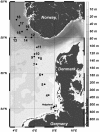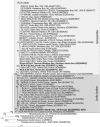Distribution of Roseobacter RCA and SAR11 lineages in the North Sea and characteristics of an abundant RCA isolate
- PMID: 20596072
- PMCID: PMC3105675
- DOI: 10.1038/ismej.2010.87
Distribution of Roseobacter RCA and SAR11 lineages in the North Sea and characteristics of an abundant RCA isolate
Abstract
The Roseobacter group and SAR11 clade constitute high proportions of the marine bacterioplankton, but only scarce information exists on the abundance of distinct populations of either lineage. Therefore, we quantified the abundance of the largest cluster of the Roseobacter group, the RCA (Roseobacter clade affiliated) cluster together with the SAR11 clade by quantitative PCR in the southern and eastern North Sea. The RCA cluster constituted up to 15 and 21% of total bacterial 16S ribosomal RNA (rRNA) genes in September 2005 and May 2006, respectively. At a few stations, the RCA cluster exceeded the SAR11 clade, whereas at most stations, SAR11 constituted higher fractions with maxima of 37%. In most samples, only one RCA ribotype was detected. RCA abundance was positively correlated with phaeopigments, chlorophyll, dissolved and particulate organic carbon (POC), turnover rates of dissolved free amino acids (DFAAs), temperature, and negatively correlated with salinity. The SAR11 clade was only correlated with POC (negatively, May) and with DFAA turnover rates (positively, September). An abundant RCA strain, 'Candidatus Planktomarina temperata', was isolated from the southern North Sea. This strain has an identical 16S rRNA gene sequence to the dominant RCA ribotype. Detection of the pufM gene, coding for a subunit of the reaction center of bacteriochlorophyll a, indicates the potential of the isolate for aerobic anoxygenic photosynthesis. Our study shows that a distinct population of the RCA cluster constitutes an abundant bacterioplankton group in a neritic sea of the temperate zone and indicates that this population has an important role during decaying phytoplankton blooms.
Figures




References
-
- Alderkamp AC, Sintes E, Herndl GJ. Abundance and activity of major groups of prokaryotic plankton in the coastal North Sea during spring and summer. Aquat Microb Ecol. 2006;45:237–246.
-
- Alonso C, Pernthaler J. Roseobacter and SAR11 dominate microbial glucose uptake in coastal North Sea waters. Environ Microbiol. 2006;8:2022–2030. - PubMed
-
- Alonso-Gutiérrez J, Lekunberri I, Teira E, Gasol JM, Figueras A, Novoa B. Bacterioplankton composition of the coastal upwelling system of ‘Ría deVigo', NWSpain. FEMS Microbiol Ecol. 2009;70:493–505. - PubMed
-
- Alonso-Sáez L, Balagué V, Sà EL, Sánchez O, González JM, Pinhassi J, et al. Seasonality in bacterial diversity in north-west Mediterranean coastal waters: assessment through clone libraries, fingerprinting and FISH. FEMS Microbiol Ecol. 2007;60:98–112. - PubMed
-
- Beja O, Suzuki MT, Heidelberg JF, Nelson WC, Preston CM, Hamada T, et al. Unsuspected diversity among marine aerobic anoxygenic phototrophs. Nature. 2002;415:630–633. - PubMed
Publication types
MeSH terms
Substances
LinkOut - more resources
Full Text Sources
Molecular Biology Databases

